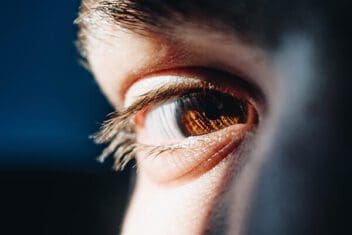Photopsia: Is It Dangerous? (How to Treat It)
Home / Neurological Disorders /
Last Updated:
A photopsia is a visual distortion caused by something inside the eye or brain. The distortions could be floaters, flashes of light, or other sudden small changes in the visual field.
Table of Contents
Causes of photopsia range from direct trauma to the eye itself to damage to the optic nerve or the brain to migraines.
While many people have floaters or flashes of light in their vision on occasion, if these suddenly appear, do not stop, or change dramatically, you should get help from a doctor immediately.
Chronic illnesses can change symptoms over time. One sign of this may be changes in photopsias. A head injury or eyeball injury could also cause photopsias.
What Is Photopsia?
A photopsia is a flash of light or something that appears to float in the eye. They look luminous. They can occur in either eye individually or both eyes at the same time. Photopsias may be temporary, occurring very quickly, or they could be permanent features in your vision.
The term photopsia has a broad definition that covers several experiences in the eye, which have several potential causes. These flashes or streaks of light are subjective, not caused by surrounding lights or something that damages the eye directly. They are pathological, indicating a more significant problem with the organ of the eye or with the brain.
If you experience a photopsia and it causes disruption in your vision for a short time, or you develop a recurring, regular, or constant photopsia when you did not have one before, get in touch with your eye doctor for a diagnosis.
What Causes Photopsia, and What Are the Risks?

While a photopsia may be a disturbing event on its own, especially if the condition comes and goes without regularity, this is not a medical problem by itself. Photopsias are typically symptoms of another condition.
Some of the most common conditions leading to photopsias include:
You deserve clear vision. We can help.
With 135+ locations and over 2.5 million procedures performed, our board-certified eye surgeons deliver results you can trust. Your journey to better vision starts here.
- Age-related macular degeneration. Often shortened to AMD, this is a common condition in the eyes of people who are 50 or older. The macular is the part of the eye that helps you see clearly in front of you. This is called central vision. AMD is the slow degeneration of the macula, leading to a loss of clear central vision. Some of the early warning signs of AMD include developing photopsias.
- Ocular migraine. Most people think of migraines as recurring headaches, but there are other symptoms alongside migraines that may not be just pain, physical sensitivity, soreness, or sensitivity to light or sound. Visual changes called auras (a type of photopsia) are associated with migraines affecting the eyes. Visual snow or static can also be symptoms of ocular migraines.
- Optic neuritis. This is inflammation that damages the optic nerve, leading to changes in how visual images are processed in the brain. The most common cause of optic nerve degeneration is multiple sclerosis. Flickering lights or flashes in the field of vision, along with pain, loss of color perception, and eventual vision loss are also part of damage to the optic nerve during optic neuritis.
- Peripheral vitreous detachment. The vitreous humor in the eyes is the gel that spans the entire inside of the eye, keeping the shape and aiding support of structures within the organ. If the vitreous humor detaches from part of the eye, this can cause serious structural problems. When the gel detaches from the retina, at the back of the eye, it may lead to slow loss of peripheral vision. This is most likely to occur due to age — older adults are more likely to experience PVD — but it can also occur spontaneously, due to an accident, or because of an illness. When it occurs too fast, this may cause flashes of light and floaters to appear in the visual field; however, these photopsias typically go away in a few months.
- Retinal detachment. The back of the eye contains the retina, which has a series of photosensitive receptor cells that collect information from light and transmit this data to the brain to be converted into images. If the retina detaches due to illness or injury, it can cause changes to the vision, including vision loss. Retinal detachment is a serious medical problem that needs immediate treatment. Suddenly experiencing floaters, light flashes, or other photopsias when you did not before could be a sign of this problem. It may require laser treatments, freezing, or surgery to keep your retina in place.
- Vertebrobasilar insufficiency. Poor blood flow to the back of the brain can cause a lot of brain damage, and one of the symptoms may be changes to the visual field, including photopsias. The back of the brain is involved in processing visual images and coordinating balance and movement. When this area is damaged, you may also experience weakness, trouble walking, and difficulty making movements happen together.
Common Photopsia Symptoms
Small specks in the eye, which often move as you move your eyes or head, are called floaters. It may look like something is on your eye or very close to your field of vision, but it is actually something inside your eye, optic nerve, or brain that is causing this change to your visual field.

When floaters first appear, they may be accompanied by flashes of light. These flashes may also occur on their own without floaters.
Light flashes in the eye are more noticeable in the dark, during the evening in dim light, or outside at night. Serious light flashes may be visible during the day.
When new floaters appear, especially if they are accompanied by flashes, it should be reported to your optometrist or ophthalmologist immediately.
Generally, a photopsia is an anomaly in the visual field. The following are signs of this condition:
- Flickering lights
- Shimmering lights or flashes
- Floating shapes in the eyes
- Moving dots, especially that move with the eyes
- Snow or white fuzz in the visual field
- Zigzag lights or flashes
- Strobing lights
- Twinkling or glittery lights
- Static
These can begin or recur during the day, at night, or both. They may be triggered when you move your head, move your eyes, experience low blood sugar, or for no reason that you can tell. Floaters or lights in the visual field associated with photopsias do not need to have a color, but some reported colors include:
- White
- High contrast
- Yellow
- Silver
- A combination of all
Photopsias may be serious, especially if they begin suddenly and are accompanied by the following symptoms:
- Dizziness or vertigo
- Physical weakness
- Headaches
- Nausea or vomiting
- Numbness
- Syncope
- Double vision
- Low blood pressure or low fluid pressure in the eyes
These physical symptoms could indicate head trauma, which is a life-threatening medical condition. They could also be associated with chronic conditions that can cause photopsia.
Regardless, get emergency treatment to diagnose the underlying problem.

Treating Photopsia
Because photopsia is a symptom, treatment depends on the underlying condition. It is a symptom of a preexisting condition, and this condition is likely to be chronic. When photopsia occurs, it may mean a change in or worsening of the condition.
There isn’t a single treatment for photopsia. Instead, the underlying cause needs to be addressed. For example, if the underlying cause is age-related macular degeneration, that is often treated with injections of anti-VEGF medications into each eye. If the cause is optic neuritis, this condition often improves on its own. If it doesn’t, steroid medications may be used.
If there is damage to some structures in the eye, the optic nerve, or the brain, the photopsia itself may not be reversible. If it gets worse, it could indicate that the underlying condition is also getting worse, suggesting that you should return to your doctor, including your optometrist or ophthalmologist, for a change in your treatment plan.
Will Photopsia Go Away on Its Own?
Again, this depends on the underlying cause. If it is due to ocular migraine or optic neuritis, photopsia will often go away on its own. If it’s due to other causes, such as age-related macular degeneration or retinal detachment, professional treatment from an eye doctor is needed.
You deserve clear vision. We can help.
With 135+ locations and over 2.5 million procedures performed, our board-certified eye surgeons deliver results you can trust. Your journey to better vision starts here.
References
- Photopsia. Merriam-Webster Medical Dictionary Online.
- What Causes Light Flashes in the Eye? LIVESTRONG.
- Floaters and Flashes. (May 2, 2005). HealthCentral.
This content is for informational purposes only. It may have been reviewed by a licensed physician, but is not intended to serve as a substitute for professional medical advice. Always consult your healthcare provider with any health concerns. For more, read our Privacy Policy and Editorial Policy.